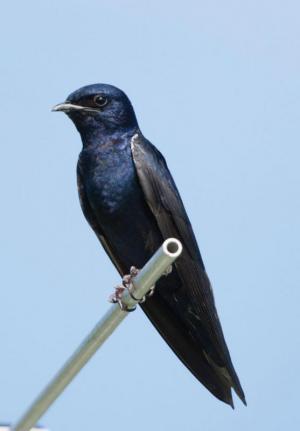Purple martin pre-migratory roosts are forming now.
North America’s largest species of swallow, purple martins nest and raise their families in North America, and winter in the rainforests of Brazil.
East of the Rocky Mountains, purple martins nest almost exclusively in human-supplied housing. They are one of America’s most well-loved species of songbirds, known for their chattering song, aerial acrobatics, insect-eating habits and tolerance of humans.
In late summer, after leaving their nesting colonies, purple martins gather in huge flocks to feed, socialize and rest before migrating. This pre-migratory roosting activity can attract hundreds of thousands of birds to sleep in one small area, arriving at sunset en masse in an amazing natural spectacle.
“As the sun begins to set, all of a sudden tens, even hundreds of thousands of purple martins appear out of nowhere in locations across the country. Their swirling acrobatics and sheer numbers are a phenomenon that everyone needs to witness,” said Joe Siegrist, president of the Purple Martin Conservation Association
Purple martins leave their roosts near dawn in a mass exodus. The number of birds leaving the roost at the same time is large enough to be detected on weather radar, looking like an expanding ring on the radar map. By studying radar data, the conservation association is able to locate possible roosts around North America.
Roosts are typically associated with larger bodies of water where reed beds and dry islands with low, thick vegetation provide sanctuary from predators, and a microclimate warmer and less windy than land. Roosts are also found in urban and suburban settings, sometimes formed in trees or on man-made structures such as bridges and pipes.
Depending on location, roosting can begin in mid-June and run through mid-September, peaking from late July to early August. Martins can come from hundreds of miles away to roost. Individual birds may use a roost for several weeks before migrating, but the roost itself may last for 8-12 weeks or more.
To follow along with the purple martins’ roosts and learn how to help conserve this treasured bird, go to purplemartin.org. Roosts are currently occurring all over the United States. To see a map of roost locations, go to roost.purplemartin.org.
To learn how to attract and care for purple martins, request a free booklet by emailing info@purplemartin.org or calling 814-833-7656.














.jpg)









































